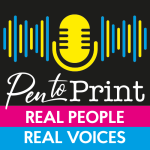By Claire Buckle
Years ago, when I first started writing short stories, I’m sure I wasn’t alone in feeling bewildered by all the writing advice on offer. I read ‘How To’ books and magazine articles, attended workshops, took courses in creative writing and tried to absorb the cornucopia of advice available on becoming a successful writer. But whereas an article might suggest one piece of advice was a ‘golden rule,’ another would contradict it.
As the current Write On! theme is ‘Contradictions,’ I thought it would be interesting to examine some of this conflicting advice.
Always Fill Out A Characters Sheet vs Character Sheets Aren’t A Necessity
You may well have come across character sheets. If not, you can find examples on the Internet. They comprise a list of questions for the writer to answer about a character in order to get to know them better. Questions might range from simple ones, such as describing a character’s physical appearance, to more personal ones, like what is their greatest fear? One website I came across suggested a writer answer 23 questions about basic characteristics, 11 in-depth more personal questions and then 35 more as the character developed. So would a character seem two-dimensional if a writer didn’t adhere to this advice?
I have never used these sheets for any characters in my stories. My characters are a mixture of people I’ve come across, which then become building blocks for my imagination to work on in order to make them unique, rather than merely a composite of real people. However, if the idea of developing a character using a sheet appeals to you, then you’d be in good company. Jo Jo Moyes, author of the hugely successful Me Before You, said in an interview that she likes to know what her character has in the fridge, what they carry in their handbag and also tests them to see how they’d react if they saw someone kicking a dog!
Maybe it’s more likely that novelists rather than short story writers use character sheets. They might want to bring more personal details about their characters into the story. However, I like my characters to reveal themselves as the story progresses rather than know every detail about them before it starts.
Write For Yourself vs. Write For An Audience
To quote the writer Melinda Haynes: “Forget all the rules. Forget about being published. Write for yourself and celebrate writing.”
I agree with the advice if you’re happy to keep the work to yourself – if you’re writing a journal, for example, or you’re not yet confident enough to share your work – but if you want to submit your stories for publication, you must bear the readers in mind. This is especially important if you’re submitting fiction to magazines. You should read those magazines and understand the type of stories they publish. For example, Woman’s Weekly will print more contemporary stories than The People’s Friend, which favour gentle tales and states in its guidelines to avoid content that might upset their readers.
Whether you’re writing a personal journal or a novel you hope will reach a wide audience, enjoy the process, otherwise what’s the point? But write about something that interests you and weave it into a story that captures your reader. I always write a story I want to read.
One undisputed piece of advice is to follow all the guidelines, whether you’re sending to a magazine or a competition. Submit work in the wrong font or double-spaced when it should be single and your story is likely to be disqualified.
Write Every Day vs. Take Time Out
It seems there’s more advice to write every day than to take time off. In his book, On Writing, Stephen King recommends writing each day — and it certainly worked for him! However, attempting to write daily, especially if you work full-time and have other commitments, can lead to guilt if you miss a day, or a word target is incomplete. This can cause dejection, a lack of motivation, or even a sense of failure!
And yet, for many people, establishing a routine is vital. They keep to a strict timetable to be productive. This has never worked for me, and it’s important to find what works for you. Don’t feel anxious if circumstances prevent you from having a daily writing practice. My tip would be to establish a goal instead. For example, I might aim to get a story out to a magazine on a certain date, so I work towards that. One day I might have several hours I can spend on that story, whereas other demands take up the next few days.
Years ago, I attended a weekend writing workshop run by an award-winning novelist. I had three teenage daughters at home and just a couple of my stories had been published. The novelist asked me how I prepared to write, saying he meditated for 20 minutes before he put pen to paper. I admitted I wrote when I had the chance, with no time for meditation, and 20 minutes might be all the time I could dedicate to writing.
I mull over a story for days or even weeks, yet still consider this part of the writing process. I write in my head while walking the dog or doing the ironing, so I suppose it’s a form of multi-tasking meditation. As Agatha Christie said: “The best time for planning a book is while you’re doing the dishes.” I would add, it’s also useful on a commute or any journey by public transport. Social media can swallow up so much time these days. If you while away a journey by scrolling on your phone, try planning or writing instead.
Edit As You Write vs. Don’t Edit Until You’ve Finished The Draft
Much of the advice is in favour of editing once you’ve completed a substantial amount of writing, or, if you’re writing a short story, once the first draft is finished. Apparently, editing uses a different side of the brain to the creative process of writing and doing both is, as one website put it: Destructive. A writer can get stuck in the pursuit of perfection and cannot move forward. The following is a quote from John Steinbeck: “Write freely and as rapidly as possible and throw the whole thing on paper. Never correct or rewrite until the whole thing is down.”
Yet, editing as I go along works for me and my tip is not to be put off by advice that tells you otherwise. I don’t mean I ponder every sentence I write, but I do scribble down the start of a story, having, as I’ve already mentioned, thought it through. Once I’ve done that, I type it up. I might only have the first few paragraphs handwritten, but, once on the keyboard, I edit as I go along and then continue with the story, going back and forth with changes. This process gives me a clear picture of how to proceed with the story. When I’ve left a story unfinished, I’ll go over what I’ve written when I next open the file and edit before continuing.
The Irish novelist, Anne Enright, says: “I work the sentences and the rhythms all the time. I can’t move on from a bad sentence. It gets more and more painful, like leaving a child behind you on the road.” I wouldn’t go that far, but I can’t move on from a chunk of the story I feel isn’t working. Remember, writing should be enjoyable! Don’t forge ahead with a piece of writing when you’d rather polish what you’ve already written. I love the following quote from Roald Dahl: “By the time I am nearing the end of a story, the first part will have been reread and altered and corrected at least one hundred and fifty times.” My kind of writer!
Plotters vs Pantsers
If you don’t already know, a pantser is someone who writes by the seat of their pants, i.e. they don’t have an outline for a plot. A plotter likes to have a clear idea of the plot before they write.
Perhaps writing without an outline is more prevalent among writers where the plot might be less significant than the characters’ internal conflicts. Long and complex novels may require meticulous planning. The author John Grisham says: “The more time I spend on the outline, the easier the book is to write. And if I cheat on the outline, I get into trouble with the book.”
Find out what works best for you. I would lose enthusiasm for a story if I had to plot it out beforehand on paper or screen. I’d feel restricted, whereas, by having it play out in my imagination, there’s the freedom for different paths to be taken. The multi-million-selling author, Jill Mansell, says: “I don’t really plan the books. I have no idea when I start. I have to have one or two brief ideas and see where it takes me.” Claire McGowan, crime writer and creative writing tutor, says she’s never been a planner and never has an outline, but does some planning once she gets into the book. The right balance, perhaps?
To end, I’d like to leave you with this advice from the author Michael Moorcock, who sums up my feelings about all the conflicting advice out there: “Ignore all proffered rules and create your own, suitable for what you want to say.”
Happy Writing!
(c) Claire Buckle, 2023
Read the latest issue of Write On! (15) magazine online here.
You can hear great new ideas, creative work and writing tips on Write On! Audio. Find us on all major podcast platforms, including Apple and Google Podcasts and Spotify. Type Pen to Print into your browser and look for our logo, or find us on Anchor FM.
*****
If you or someone you know has been affected by issues covered in our pages, please see the relevant link below for information, advice and support: https://pentoprint.org/about/advice-support/



